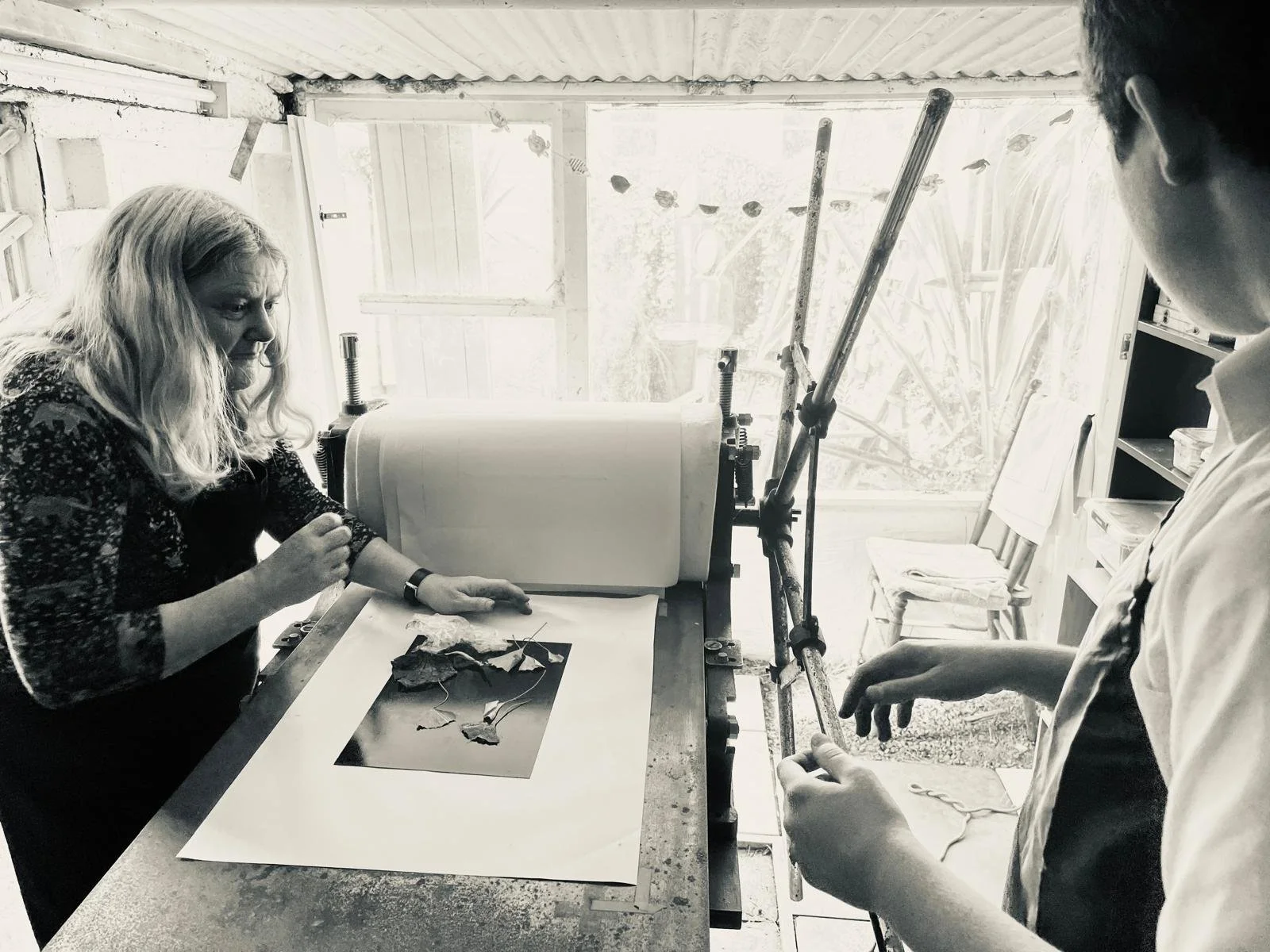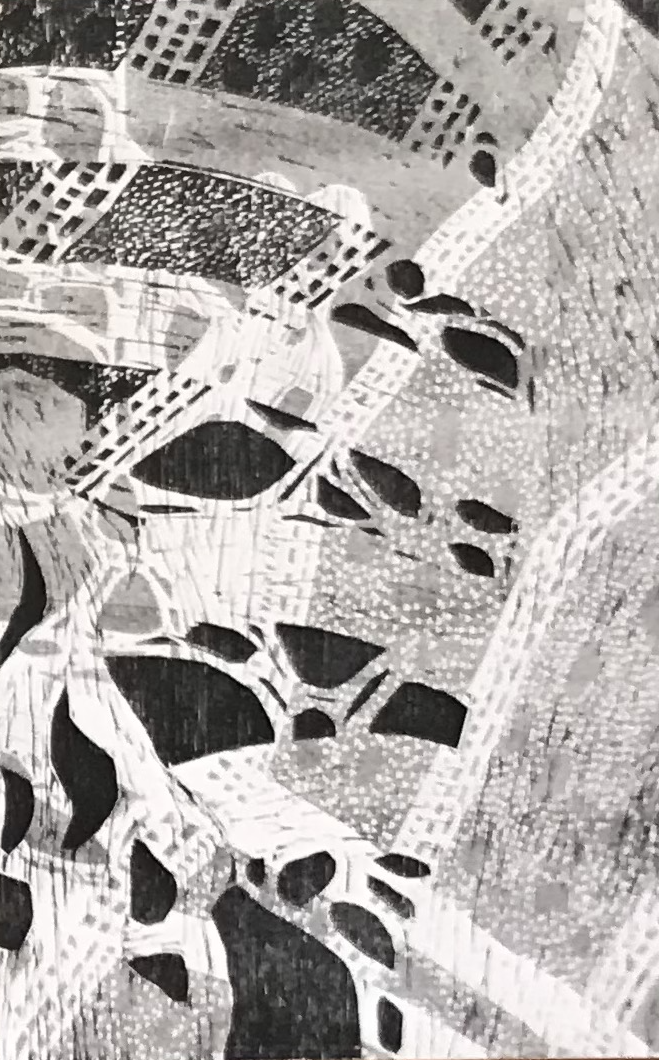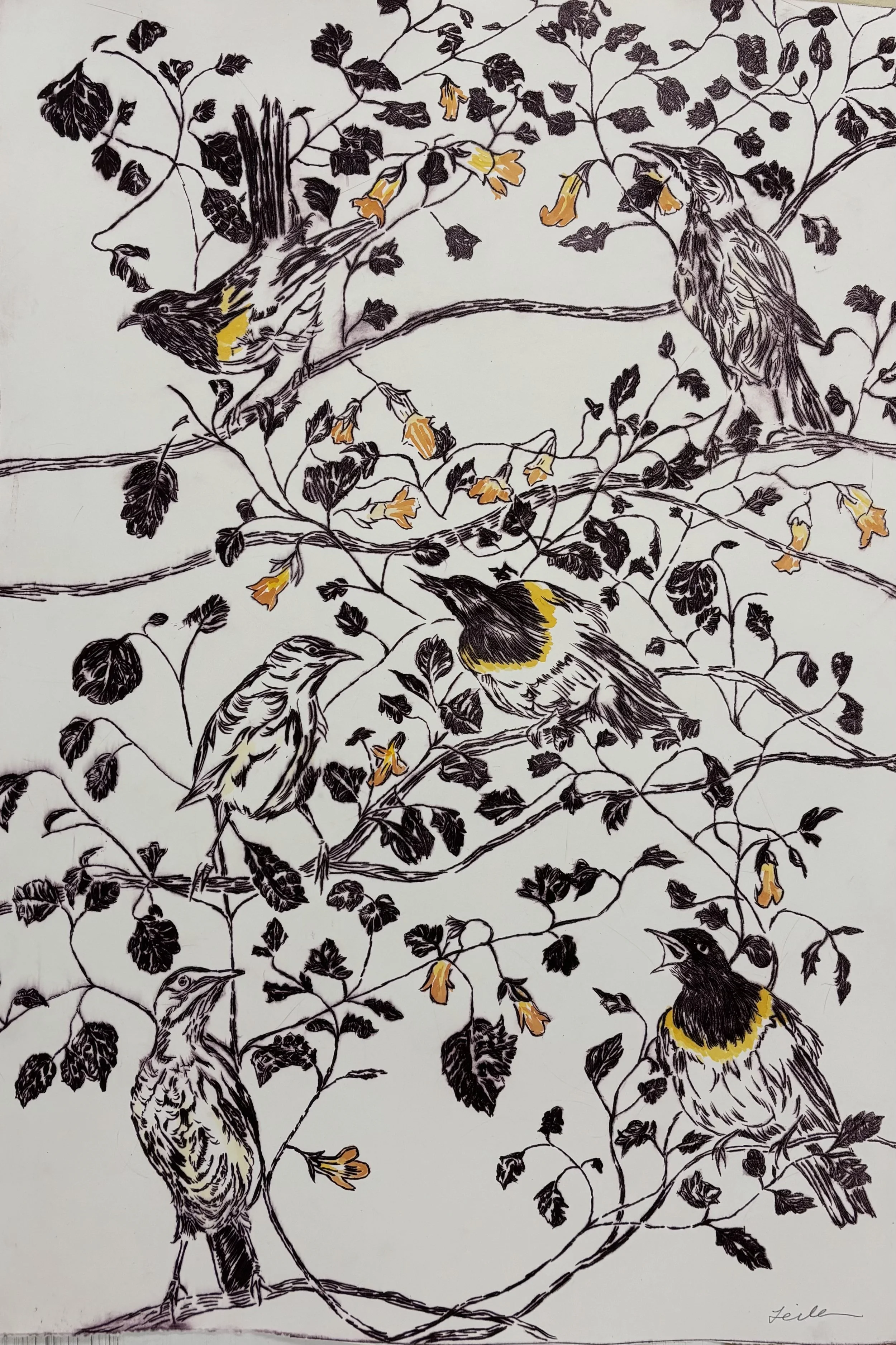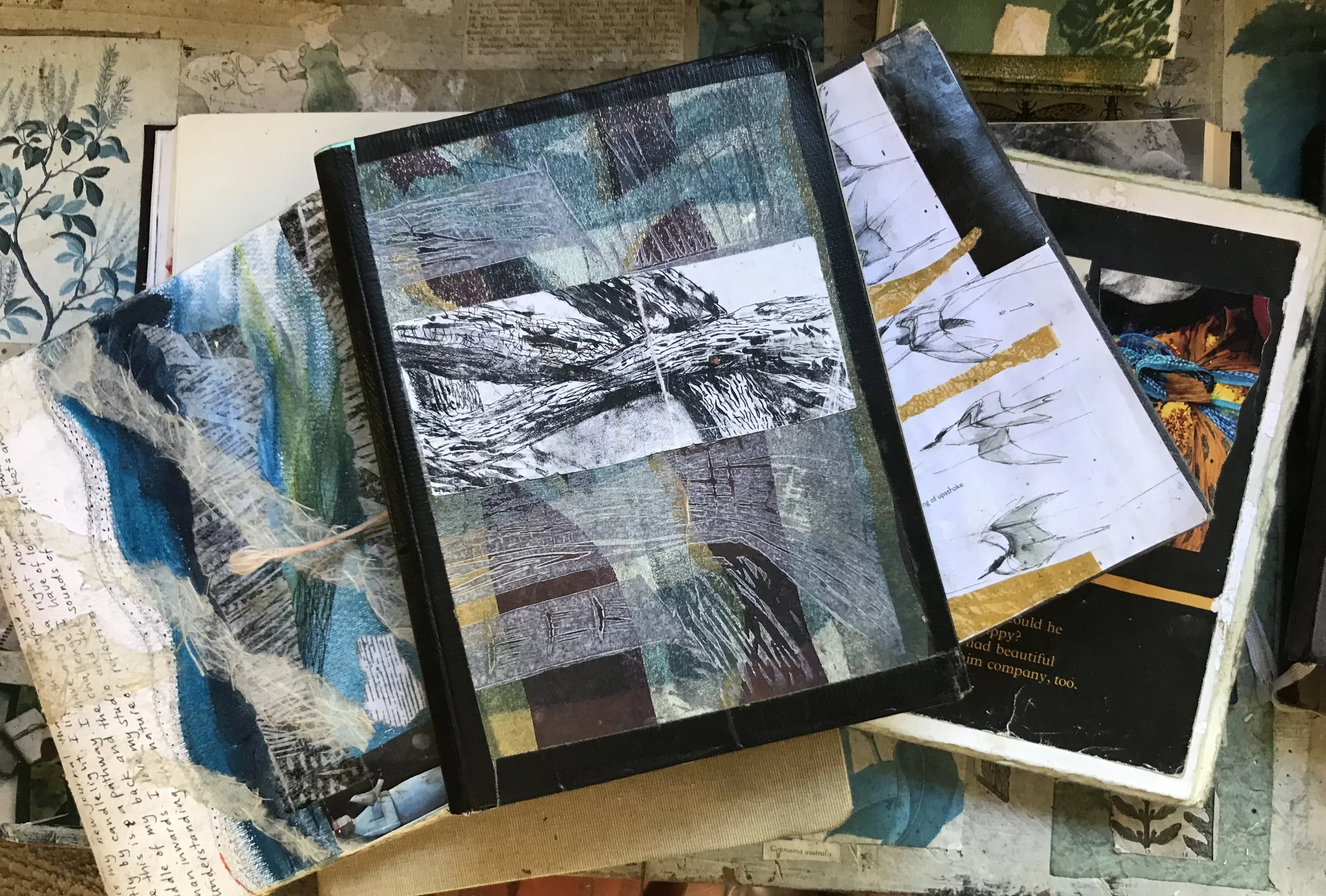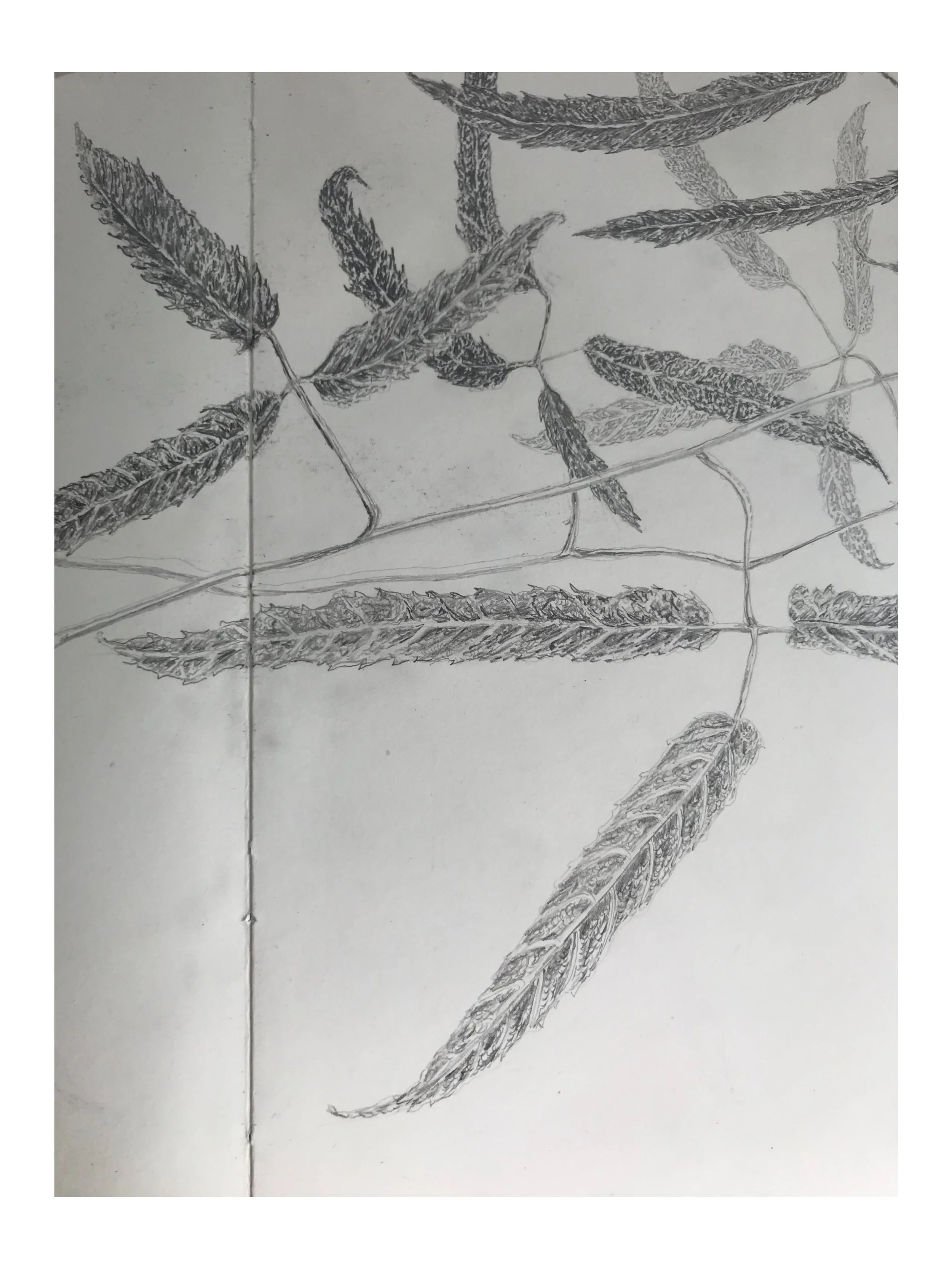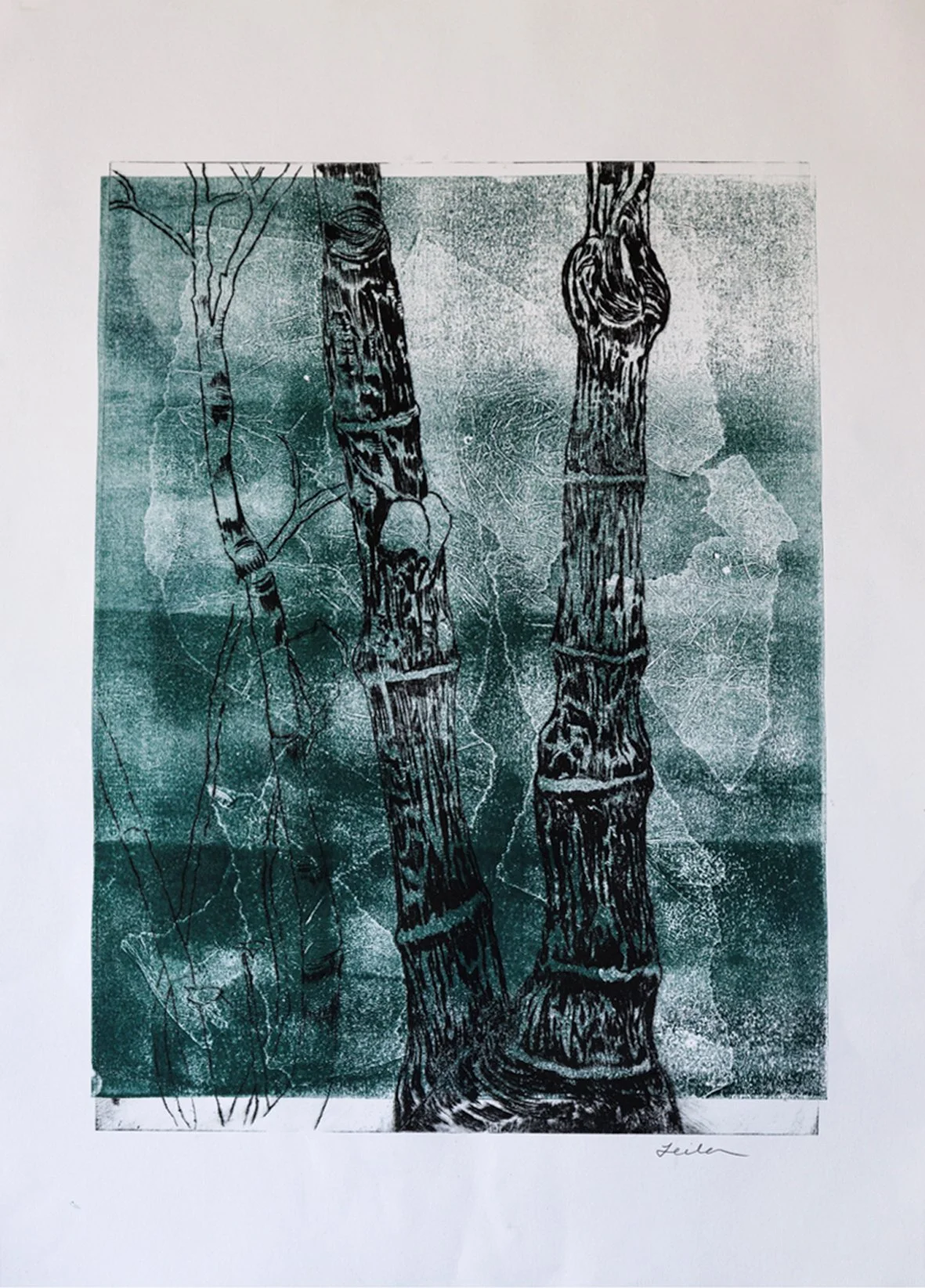I was lucky to discover on Waiheke, growing naturally on the steep cliffs of a dried water way, Taurepo (Rhabdothamus solandri). Taurepo is a little twiggy shrub with grey-green leaves and stems. It has outstanding trumpet shaped orange flowers striped with yellow. It grows in the shade and yet the flowers are bright and delicately shining in the dark rocky enclaves that I found it in. This little plant I was to find out is a new comer in the the evolution of our endemic plant species and was often pollinated by hihi one of our unique and oldest birds. The hihi, one of New Zealand’s rarest birds, has traditionally been placed in the Meliphagidae (honeyeater) family along with the bellbird and the tūī. However, apart from diet, hihi share few qualities with tūī and bellbird, and recent DNA analysis confirms that hihi are the sole representative of another bird family (Notiomystidae) found only in New Zealand, whose closest relatives are the iconic wattlebirds that include kokako, saddleback and the extinct huia.
In pre-European times Hihi were found throughout the North Island and the surrounding islands. I think it would have been prolific on Waiheke Island right up until 1830s. It became extinct on the mainland in 1883 with the only naturally surviving population of hihi found on Te-Hauturu-o-Toi (Little Barrier Island) in the Hauraki Gulf. When I came to create these pieces, I found my first designs reminiscent of wallpaper in the 1880s – I thought of William Morris, his abstraction of natural forms that stemmed from direct observation of the organic shapes and curves of the flora and fauna around him and as I read the history of wallpaper, its production and use became popular at the same time as the hihi became extinct in the North Island.
Printmaking
I have four modalities within printmaking that I practice, these are woodcuts, monoprint/relief, drypoint and mezzotint. Each of these modalities offer different channels of expression around the essential quality that I am communicating.
I particularly enjoy the sculptural process of the woodcut. Woodcut encourages a simplicity of line that I find expressive. Mezzotint takes time and physical exertion; I am still working out the technical processes of it – however the result can be very satisfying, and I particularly like the idea of combining mezzotint with my writing as an equal component. Drypoint can express a line like a drawing and so I feel it works well when it evolves directly from my drawing. I like to combine the drypoint process with monoprint – this can sometimes be challenging as it increases the accidental component of printmaking.
There is time in the field, observing, drawing and note taking in my journal that is the springboard for my printmaking practice. In the studio it’s a time of thinking, looking and designing. I particularly love it if I can convey in my drawing some wild essence and I know if I can get that in the beginning it will be somehow present through all the permutations of the print making process. It is also at the early stages of visioning the artwork that I get a feel of what modality best communicates that essence.
Place is very important in my art, and not only is it conveyed through the work, but it is also important for me the position of my studio in my garden. I do my printmaking in the print studio of the Red Shed, Palm Beach Waiheke Island.
Conservation
I observe and spend time in nature. I think about the history and conservation of our endemic species and healthy forests. I was very happy to be invited to submit some work for the understory exhibition at the Waiheke Art Gallery - An exhibition about the changing forest on Waiheke curated by Monica Peters and Jeanine Clarkin. The following artworks are three individual and theme connected pieces, called Hidden Harmony - Hihi and Taurepo
To Māori, ‘hihi’ was a term used for the healing rays of sunlight. The shoulders of the male hihi would light up in a burst of yellow as these birds darted through the trees and were said to be carriers of the sun - capturing the healing rays and spreading light through the forest. As one of the first species to vanish from mainland bush, these sensitive birds can be an indicator of forest health and a test of ecological restoration. For these reasons, hihi symbolise life, vigour, and health of the forest. I hope that one day hihi will once more occupy this island bringing health to our forests here. These three artworks explore the journey off hihi from the past, the present and the future.
Size: each piece 420 mm x 594 mm (unframed)
Approximately 500 mm x 680 mm framed
Medium: Drypoint and monoprint on Hahnemühle paper
Drawing
I am interested in expressing through my art the intangible essence within the natural world. I journal consistently, sketches of landscapes, birds, plants – the notebook is both an exploration of how I see and a journalistic tendency to write down impressions. It is the way I attend to the world around me. Drawing is an act of attendance, an act of love. I am compelled to sit and gaze and give time to what I see and to allow space to grow within me.
journals
I often create my journals and collage the covers with my printmaking. I like to carry them everywhere, a drawing, a small attendance to everyday.
Place
every drawing is also about place for me. This drawing of tātarāmoa was done at Whakapapa, Tongariro national park. I remember the time of sitting and attendance, the whiteheads moving through the tops of the trees, the sound of whakapapaiti stream.
drawings inform my art practice
sometimes I work my drawings into my printmaking - particularly drypoint etchings - sometimes its the memory of the act of the drawing that informs my printmaking. this drawing is at Te Toki reserve on Waiheke Island - they are shelve fungi on a dying taraire. What I didn’t capture in the moment was the drifts of steam rising up from the fungi in the early morning light. This may come later, through memory, a layer perhaps through relief/monoprint.
Printmaking
I become immersed in the process of printmaking, losing a sense of time, as I explore the relationship of art-making with an etching press. The serendipitous marks, the heartache and the absolute joy of uncovering the unexpected as I lift the felts and then the paper in that final act after its gone through the press. I enjoy the reflective practice of building the plate, the slow crafting, the shifts and changes of image as it meets the materials of wood or metal and the different tools I use to shape the plate.
Kawakawa; Heart behind heart
Medium: drypoint with Monoprint on hahnemühle paper
Size: 590 mm h x 470 mm w
framed.
currently displayed at John Kinder House.
Standing Place
Standing Place is an exhibition of the works of Leila Lees and Lisa Davidson, currently showing at John Kinder House, 2 Ayr St, Parnell.
Standing place is inspired by the concept of turangawaewae, this encompasses for me the sensory world, the world perceived through heart, the physical practical world and the essence of what lies behind what we see. Standing place is an act of love. The act of love as attention and stewardship. I grew up in Piripai in the outskirts of Whakatane. My book Piripai is a testament to my standing place. I think of standing Place as remembering, remembering our ancesters, and acknowledging who was here before, who we stand upon.
I have really appreciated working with Lisa Davidson exploring the layers in our shared theme of standing place; a sense of place, of where we come from, our sense of inner space and how we perceive through the lenses of our lives lived and how everything connects- the places that are important to us, the people that have shaped us, the ancestors that made choices to uproot and to put down roots and our art and for me my writing as well, that hones us.
Lineage
moths break open / holes
create spaces to traverse / and silences around things
whilst the ancestors wing through to the temporal world
Medium: Reduction cut woodcut on hahnemühle paper
with hand colouring
Twelve panels each 420mm h x 295 mm w
Overall size: 1,350 mm h x 1,270 mm w
Threshold
a passage from one mode of life to another
becomes detached a little from its surroundings
a threshold is neither inside or outside
the crossroads are the junction of roads, yet belong to none of them
the liminal place offers a variation of options
with no reassuring certainty
crossing into the temporal world
there is a shift, a wobble in perception,
light wavers and settles
Light Attends
Medium: drypoint with Monoprint on hahnemühle paper
Size: 590 mm h x 470 mm w
Ladder with no Rungs
Ladder With No Rungs is an exhibition at the Red Shed Art Gallery featuring artwork by Leila Lees. In this series of monoprints, woodcuts and drypoint etching, Leila has taken for inspiration Mike Johnson’s poems in the book Ladder With No Rungs. These three-line, haiku-style poems explore the paradox of human experience, and the absolute interconnectedness and non-hierarchical nature of the universe. These poems were written during and recovering from a severe illness, and deal with the process of experiencing love, life and death fearlessly and with vulnerability. The artwork is layered, and reflects the simplicity and complexity that play hide and seek in the poems. The images mirror the light and shadow revealed through the stripping away and breakdown of what has accrued through a life. Both art and words come together through the book Ladder With No Rungs and will be on sale at the Red Shed during this exhibition.
Between the uprights and the crosspiece
Between the uprights and the crosspiece stars flow. Monoprint
between the uprights and the crosspiece
stars flow
ghosts thread in and out
Behind the form
Behind the Form. Monoprint
behind the form we find
the shape of the movement
that gives rise to it
Fir forest with Jackdaw
drypoint etching with chen colle, framed 520x 520
Fir forest with Jackdaw
drypoint etching with chen colle, framed 520x 520
SOLD
I drew the jackdaw when I was in Keswick, Cumbria. When I made an etching from it, its crow like intelligence and the way it had that mysterious yet penetrating glance brought the fairy tale experience like an invitation into the underworld. Here in the forest, you might become lost, there might be destabilization and diffusion. There is also initiation, an initiation into the underworld and also an initiation into life.
Fir forest – yellow ochre/black
drypoint etching 300x 400 unframed on hannemulle
Fir forest – yellow ochre/black
drypoint etching 300x 400 unframed on hannemulle
I started to explore the flipping of the image to communicate the experience of having your world tipped up when entering the forest. The way we perceive shadow and light, what we see and how our beliefs come into scrutiny.

